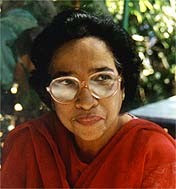
In the good old days when Calcutta was the capital of British India, foreigners thought it was a nice place to work, live or visit. Whether civilians or military officers, missionaries or infidels, traders or gamblers of English, Scottish, French or Greek descent, they overran the city, until British India was firmly and permanently edged out by Bharat Mata.
A stroll through the numerous graveyards with their ornate tombs that dot the city, transports us back through the archives of Time, conjuring up lives that were sometimes extraordinary.
In the St. John’s Churchyard on Council Street very close to the Hooghly, lie the remains of Begum Frances Johnson, the Grand Dame of 18th century Calcutta – a woman who was born and brought up in India, and chose to die in the country of her adoption. Neither the heat, dust nor noise of the city could drive her out of her beloved Bengal.
However, there was no compromise on her style of living, and like a true English lady she had dinner at 4 p.m, and then entertained till the wee hours of the morning. Always dressed in lace, truffles, buttons or bows, she was extremely popular as a hostess. Only the high and the influential dined at her table. The likes of Warren Hastings and his wife, Lord Cornwallis, Lord Morrington and Arthur Wellesley Duke of Wellington were her regular invitees. Frances lived in style with nine slave girls (Bengali or African) to do her bidding.
But Begum? Where did the English lady acquire such a title? Was she married to an Indian? Her story unfolds like a fairy tale – sometimes amusing, sometimes sad. Her life was an intriguing chiaroscuro of sunlight and shadows.
Frances was a popular socialite with a wide circle of influential friends. The Nawab of Bengal admired and treated her with great respect. His mother Amina Begum became a very dear friend. It was because of this close association that Frances came to be known as Begum Frances Johnson.
Francis was born at Fort St. David on the Coromandel Coast, on April 10th 1728. Her father Edward Croke was the governor of the fort, under the East India Company. Her mother Isabella Beizor was of Portuguese descent.
Frances’ foray into marriage was jinxed from the start. At the age of 13, she was married to Perry Peupler Templar in Calcutta. The marriage ended with his death five years later. She bore him two children who died in infancy.
Her second marriage to a merchant James Altham was cut short in ten days, when he succumbed to small pox.
Two years later, she married William Watts a company agent at Cossimbazaar. It was a long lasting and happy marriage. She bore him three children and was pregnant with the fourth, when the Nawab of Bengal Siraj-ud-daula attacked the fort in 1756. Watts offered no resistance but meekly surrendered. Because of Frances’ close association with his mother, Frances and children were allowed to stay on at the fort. They were then moved to Murshidabad and later to Chandernagore, when Calcutta was seized by the Nawab.
Calcutta was soon reclaimed by Clive, and Frances was able to join her husband. Because the Nawab regarded her so highly, she was sent by the British to negotiate with him after his defeat at the Battle of Plassey in 1757.
Two years later, Walter and his family went back to England. But after his death in 1764, Frances who didn’t like the English weather returned to Calcutta in 1769, and settled down at 12, Clive Street where she stayed till her death. At 36, having outlived three husbands, she was a wealthy woman.
But in 1774, she blundered into a fourth marriage with the Reverend William Johnson, Chaplain of St. John’s Church. He was 16 years her junior who preened himself like a peacock, and was extremely unkind to her. This ill-conceived folly can only be attributed to her midlife insecurities. In spite of her wealth and social life she was lonely. But the man chipped at her self confidence. So in 1787, she had the marriage annulled and he was sent back to England with a handsome annuity from her.
Begum now 59 years old, and was happy and at peace. Of her five grandchildren, four returned to serve in India. One of them was the Earl of Liverpool. Frances lived till the ripe old age of 83. She died on 3rd February 1812, after a series of mini strokes and multiple abscesses. She was buried on the site she had chosen, opposite the ornate mausoleum of Job Charnock, founder of Calcutta, in St. John’s Churchyard. Her funeral was well attended by the bigwigs in town, which included the Governor General and Chief Justice of Calcutta. On her impressive tomb is a lengthy inscription summing up the life of this beloved ‘Grand Dame of Calcutta.’







No comments:
Post a Comment